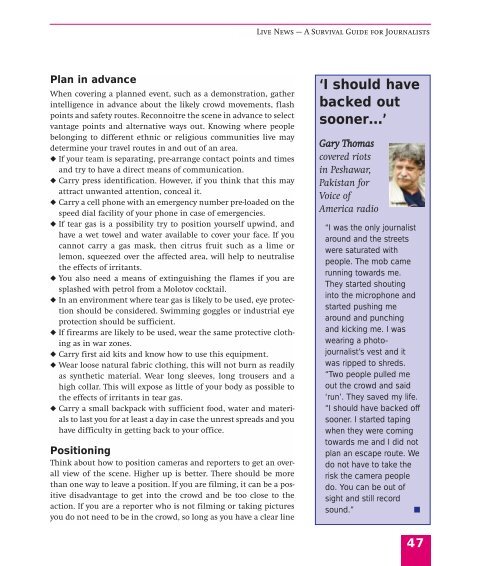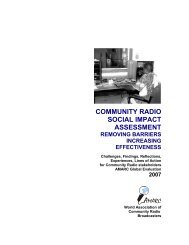Live News - A Survival Guide - International Federation of Journalists
Live News - A Survival Guide - International Federation of Journalists
Live News - A Survival Guide - International Federation of Journalists
- No tags were found...
You also want an ePaper? Increase the reach of your titles
YUMPU automatically turns print PDFs into web optimized ePapers that Google loves.
<strong>Live</strong> <strong>News</strong> — A <strong>Survival</strong> <strong>Guide</strong> for <strong>Journalists</strong>Plan in advanceWhen covering a planned event, such as a demonstration, gatherintelligence in advance about the likely crowd movements, flashpoints and safety routes. Reconnoitre the scene in advance to selectvantage points and alternative ways out. Knowing where peoplebelonging to different ethnic or religious communities live maydetermine your travel routes in and out <strong>of</strong> an area.◆ If your team is separating, pre-arrange contact points and timesand try to have a direct means <strong>of</strong> communication.◆ Carry press identification. However, if you think that this mayattract unwanted attention, conceal it.◆ Carry a cell phone with an emergency number pre-loaded on thespeed dial facility <strong>of</strong> your phone in case <strong>of</strong> emergencies.◆ If tear gas is a possibility try to position yourself upwind, andhave a wet towel and water available to cover your face. If youcannot carry a gas mask, then citrus fruit such as a lime orlemon, squeezed over the affected area, will help to neutralisethe effects <strong>of</strong> irritants.◆ You also need a means <strong>of</strong> extinguishing the flames if you aresplashed with petrol from a Molotov cocktail.◆ In an environment where tear gas is likely to be used, eye protectionshould be considered. Swimming goggles or industrial eyeprotection should be sufficient.◆ If firearms are likely to be used, wear the same protective clothingas in war zones.◆ Carry first aid kits and know how to use this equipment.◆ Wear loose natural fabric clothing, this will not burn as readilyas synthetic material. Wear long sleeves, long trousers and ahigh collar. This will expose as little <strong>of</strong> your body as possible tothe effects <strong>of</strong> irritants in tear gas.◆ Carry a small backpack with sufficient food, water and materialsto last you for at least a day in case the unrest spreads and youhave difficulty in getting back to your <strong>of</strong>fice.PositioningThink about how to position cameras and reporters to get an overallview <strong>of</strong> the scene. Higher up is better. There should be morethan one way to leave a position. If you are filming, it can be a positivedisadvantage to get into the crowd and be too close to theaction. If you are a reporter who is not filming or taking picturesyou do not need to be in the crowd, so long as you have a clear line‘I should havebacked outsooner…’Gary Thomascovered riotsin Peshawar,Pakistan forVoice <strong>of</strong>America radio“I was the only journalistaround and the streetswere saturated withpeople. The mob camerunning towards me.They started shoutinginto the microphone andstarted pushing mearound and punchingand kicking me. I waswearing a photojournalist’svest and itwas ripped to shreds.“Two people pulled meout the crowd and said‘run’. They saved my life.“I should have backed <strong>of</strong>fsooner. I started tapingwhen they were comingtowards me and I did notplan an escape route. Wedo not have to take therisk the camera peopledo. You can be out <strong>of</strong>sight and still recordsound.”■47
















